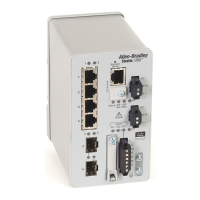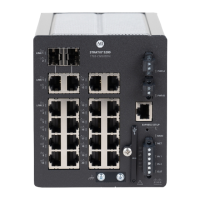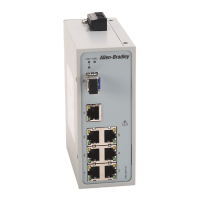252 Rockwell Automation Publication 1783-UM007G-EN-P - February 2017
Chapter 7 Configure Switch Features
Internet Group Management
Protocol (IGMP) Snooping
with Querier
Layer 2 switches can use IGMP snooping to constrain the flooding of multicast
traffic. IGMP snooping dynamically configures Layer 2 interfaces so that
multicast traffic is forwarded to only those interfaces that are associated with
IP multicast devices. IGMP snooping requires the LAN switch to snoop on
the IGMP transmissions between the host and the router and track multicast
groups and member ports. When the switch receives an IGMP report from a
host for a particular multicast group, it adds the host port number to the
forwarding table entry. When the switch receives an IGMP Leave Group
message from a host, it removes the host port from the table entry. It also
periodically deletes entries if it does not receive IGMP membership reports
from the multicast clients.
The multicast router sends out periodic general queries to all VLANs. All hosts
that are interested in this multicast traffic send join requests and are added to
the forwarding table entry. The switch creates one entry per VLAN in the
IGMP snooping IP multicast forwarding table for each group from which it
receives an IGMP join request.
The switch supports IP multicast group-based bridging, rather than MAC-
addressed based groups. With multicast MAC address-based groups, if an IP
address being configured translates (aliases) to a previously configured MAC
address or to any reserved multicast MAC addresses (in the range 224.0.0.xxx),
the command fails. Because the switch uses IP multicast groups, there are no
address alias issues.
Table 60 defines the default number of supported multicast groups. You can
modify the number of multicast groups that are supported by using the
Command-line interface.
The IP multicast groups that are learned through IGMP snooping are
dynamic. If you specify group membership for a multicast group address
statically, your setting supersedes any automatic manipulation by IGMP
snooping. Multicast group membership lists can consist of both user-defined
and IGMP snooping-learned settings. The switch learns multicast IP addresses
that are used by the EtherNet/IP network for I/O traffic.
IGMP implementation in the switch is IGMP V2. This version is
backward-compatible with switches running IGMP V1. The switch has a built-
in querier function, and the global macro enables on IGMP Snooping and the
querier.
Table 60 - Default Supported Multicast Groups
Switch Default Multicast Groups
Stratix 5400 and Stratix 5410 switches 1024
Stratix 5700 and ArmorStratix 5700 switches 256
If you exceed 180 multicast groups, we recommend that you switch to the routing SDM template via Device Manager.
Stratix 8000 switches 256
If you exceed180 multicast groups, we recommend that you modify the number of multicast groups by changing the
SDM template to the Lanbase Routing template via Device Manager.
Stratix 8300 switches 1024

